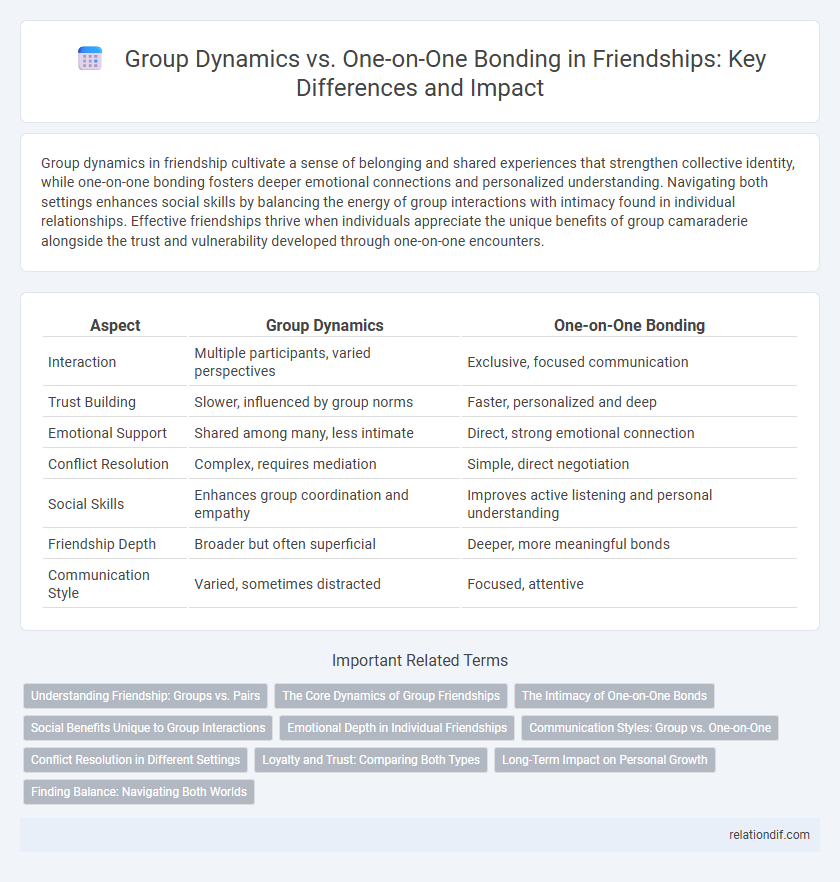Group dynamics in friendship cultivate a sense of belonging and shared experiences that strengthen collective identity, while one-on-one bonding fosters deeper emotional connections and personalized understanding. Navigating both settings enhances social skills by balancing the energy of group interactions with intimacy found in individual relationships. Effective friendships thrive when individuals appreciate the unique benefits of group camaraderie alongside the trust and vulnerability developed through one-on-one encounters.
Table of Comparison
| Aspect | Group Dynamics | One-on-One Bonding |
|---|---|---|
| Interaction | Multiple participants, varied perspectives | Exclusive, focused communication |
| Trust Building | Slower, influenced by group norms | Faster, personalized and deep |
| Emotional Support | Shared among many, less intimate | Direct, strong emotional connection |
| Conflict Resolution | Complex, requires mediation | Simple, direct negotiation |
| Social Skills | Enhances group coordination and empathy | Improves active listening and personal understanding |
| Friendship Depth | Broader but often superficial | Deeper, more meaningful bonds |
| Communication Style | Varied, sometimes distracted | Focused, attentive |
Understanding Friendship: Groups vs. Pairs
Group dynamics in friendships foster diverse perspectives and collective problem-solving, enhancing social skills and empathy through shared experiences and communication within multiple members. One-on-one bonding allows for deeper emotional connections, personalized support, and intimate understanding, promoting trust and vulnerability between individuals. Balancing group interactions and individual relationships is essential for nurturing comprehensive social development and maintaining meaningful friendships.
The Core Dynamics of Group Friendships
Group friendships revolve around shared experiences, collective trust, and mutual support, fostering a sense of belonging through diverse interactions. Core dynamics include balanced communication, emotional reciprocity, and conflict resolution, which maintain harmony and strengthen group cohesion. These elements contrast with one-on-one bonding, where intimacy and individualized attention dominate the relational structure.
The Intimacy of One-on-One Bonds
One-on-one bonds foster deep intimacy by allowing individuals to share personal experiences, emotions, and vulnerabilities without distraction. These connections build trust and understanding more effectively than group dynamics, where attention is divided among several participants. Intimate friendships formed through one-on-one interactions often lead to stronger emotional support and long-lasting loyalty.
Social Benefits Unique to Group Interactions
Group dynamics foster social benefits such as enhanced communication skills, collective problem-solving, and increased emotional support, which are less prominent in one-on-one bonding. Within group interactions, individuals experience diverse perspectives, develop empathy, and build a sense of community that strengthens social cohesion. These unique social benefits contribute to improved collaboration and resilience in both personal and professional relationships.
Emotional Depth in Individual Friendships
One-on-one friendships allow for deeper emotional connection and vulnerability, fostering trust and understanding that group dynamics often dilute. Individual bonds provide a safe space for personal sharing, enabling friends to address unique experiences without distraction. This focused attention enhances empathy and support, creating lasting emotional depth unattainable in larger social circles.
Communication Styles: Group vs. One-on-One
Group communication thrives on inclusive dialogue and multiple perspectives, fostering diverse interactions and shared understanding. One-on-one bonding allows for deeper emotional expression, personalized feedback, and focused attention, enhancing intimacy and trust. Tailoring communication styles to each context maximizes connection and relationship quality within friendships.
Conflict Resolution in Different Settings
Group dynamics in friendship often involve navigating diverse perspectives and managing multiple relationships simultaneously, which can complicate conflict resolution but also foster collective problem-solving skills. One-on-one bonding allows for deeper emotional connections and more personalized communication, making it easier to address conflicts with empathy and immediate feedback. Understanding these differences aids in selecting appropriate conflict resolution strategies tailored to either group settings or individual friendships.
Loyalty and Trust: Comparing Both Types
Group dynamics in friendships foster a collective loyalty driven by shared experiences and mutual support, creating a network of trust that benefits from diverse perspectives. One-on-one bonding cultivates deeper individual trust and loyalty through exclusive attention and personalized communication, strengthening emotional connections more intensely. Both settings contribute uniquely to trust and loyalty, with groups enhancing social cohesion and pairs emphasizing intimate reliability.
Long-Term Impact on Personal Growth
Group dynamics foster diverse perspectives and social skills through interactions with multiple personalities, enhancing adaptability and empathy over time. One-on-one bonding enables deeper emotional intimacy and trust, promoting significant self-awareness and personal reflection. Both settings contribute uniquely to long-term personal growth by balancing social complexity with intimate connection.
Finding Balance: Navigating Both Worlds
Balancing group dynamics and one-on-one bonding requires understanding the unique benefits each brings to friendship, with groups fostering a sense of community and shared experiences while individual connections deepen emotional intimacy. Recognizing when to engage in collective activities versus private conversations helps strengthen trust and communication across different social settings. Navigating both worlds enhances social skills, promotes empathy, and ultimately supports well-rounded relationships.
Group dynamics vs One-on-one bonding Infographic

 relationdif.com
relationdif.com